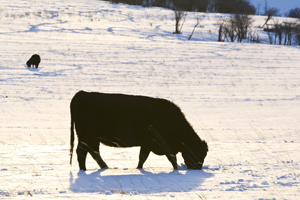3 Tips for Swath and Bale Grazing

We’ll soon see cattle out in fields cleaning up swaths or feeding on bales. If you’re planning to feed your cattle this way into the winter months, here are a few recommendations to consider from a recent BCRC webinar.
Extended grazing methods, including swath, stockpiled and bale grazing, have considerable economic benefits over traditional winter feeding systems, such as reduced labour, equipment, feed and manure handling costs.
The related webinar, held last fall, featured Vern Baron, PhD, a Research Scientist for Agriculture Agri-Food Canada (AAFC) in Lacombe, Alberta, and John Duynisveld, a Research Biologist for AAFC in Nappan, Nova Scotia.
They discussed both swath and bale grazing and offered tips for producers across the country, including:
Match the animal to the forage (22:50)
Successful extended grazing programs match the energy requirements of the cow with the true quality of the forage and/or supplement being offered. Knowing the true quality of the feed, by reviewing the results after sending samples to a lab for feed analysis, is the first and critical step to a successful winter grazing program.
It takes 20% more energy on average for cows in an extended grazing system than in a dry lot system because of the extra energy they use to search for feed and to stay warm in grazing conditions. This means cows must be in good condition to be able to face the demands of winter grazing.
Some classes of cattle are better prepared to meet these demands. Dry cows in good body condition are the best suited. Weaned calves are the least suited for winter grazing.
Both animal requirements and forage quality change over the winter months. As cows move through gestation, their nutrient requirements increase so cows may need to be provided higher quality forage, a supplement, or moved to a different management system when they get closer to calving.
Dry cows in the earlier stages of pregnancy have a lower energy requirement than cows in their third trimester or lactating cows. Therefore, there is a potential window in late fall to feed lower quality forage. However, if cows have less than ideal body condition, late fall may instead be the time to feed higher quality forages in order to increase their condition before their energy requirements increase in second and third trimesters. Testing your feed and body condition scoring your cows can help you determine which option is right for you.
Leave extra biomass on the field to help reduce problems with mud: (29:30)
With cattle in extended grazing systems being more exposed to the elements than cows in a dry lot situation, it takes you more effort to be prepared for whatever mother nature will throw at you. Being unprepared for harsh whether can result in cows losing body condition and therefore may have more calving difficulties, lower calf birth weights, and a longer post-partum interval, throwing off next year’s calving season. One tip is to ensure cows have proper lice control to keep their haircoat healthy and full all winter.
During extreme cold patches, it is advised to make sure that cattle have enough high energy feed. This may mean moving fences a little earlier and not making cattle “clean up” swaths to the same extend you would expect during milder temperatures. Ensuring good access to natural or manmade windbreaks is especially important when temperatures drop or winds pick up.
In cases where mud is an issue (late frosts, when frost is coming out of the ground, or in regions of Canada with milder winter conditions) it is advised to leave as much biomass on the field as possible. This acts as a “snowshoe”, allowing cattle to be able to walk on top of the mud. The extra root biomass also helps to hold soil together. It is recommended to move cattle more frequently when pastures are muddy. Also consider moving cattle to a different extended grazing pasture that will be broken up in the spring to prevent damage to the land you plan to continually use for grazing.
Help cattle use as much feed as possible (1:05:45)
There is value to leaving some biomass in the field in terms of improving soil organic matter, but generally speaking, the more crop that cattle utilize for energy, the more efficient the extended grazing system.
Overall utilization in extended grazing systems is relatively high with both researchers on the webinar reporting between 65-90% utilization during their research trials depending on weather conditions. Utilization declines in deep snow and therefore costs increase.
To increase overall utilization in a swath grazing system, it is recommended to build large swaths around 3-4 feet wide and 18 inches high. These big swaths are easier for cows to access even with snow cover. Choosing a type of crop and variety that is higher yielding also help to increase utilization.
Watch the full webinar for more on how different crops and varieties rank in terms of yield.
Click here to subscribe to the BCRC Blog and receive email notifications when new content is posted.
The sharing or reprinting of BCRC Blog articles is welcome and encouraged. Please provide acknowledgement to the Beef Cattle Research Council, list the website address, www.BeefResearch.ca, and let us know you chose to share the article by emailing us at [email protected].
We welcome your questions, comments and suggestions. Contact us directly or generate public discussion by posting your thoughts below.


